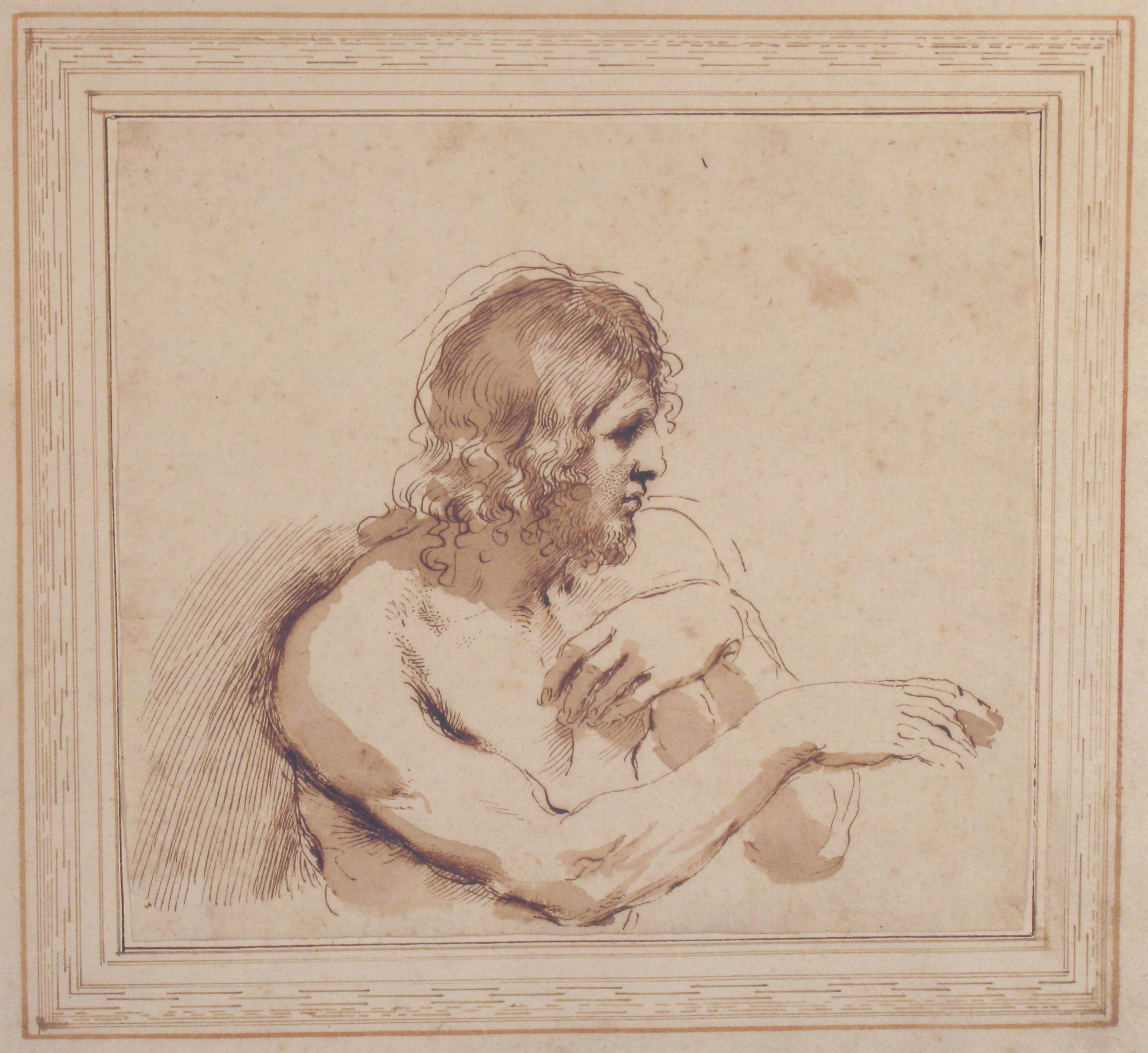Half-Figure of a Nude Man Facing Right
Guercino (Giovanni Francesco Barbieri) Italian
Not on view
Guercino drew this sparkling sheet, like the bulk of his drawings, in pen and brown ink, with additional washes to represent shadows. With great ease, the artist combined broad, sketchy passages, such as the forearms and hands, with the far more detailed and precisely drawn head. The distinctive border of the mount has an almost modern appearance, but it was applied in the early eighteenth century, probably in Italy, for the English collector John Bouverie (ca. 1723-1750), who in the 1740s acquired many Guercino drawings in Bologna.
While the figure of this drawing has not been related to an executed work, it resembles quite closely the figural types in paintings of the 1640s, as for instance the figure of Christ in Christ and the Samaritan Woman of 1647 (Modena, Banco San Geminiano e San Prospero). In this painting the figure of Christ is clothed, as well as in two autograph drawings preparatory for the same subject (Royal Library, Windsor, inv. no. 2791 and Paris, Louvre Museum, inv. 6874), and a study for Christ Appearing to Saint Theresa (Royal Library, Windsor, inv. no. 2782) shows a partially clothed Christ in a similar attitude - one hand gesturing towards a nearby figure and one hand pointing towards his chest, as if revealing his identity.
Another possible subject would be a Baptism of Christ, as the young, bearded figure is shown nude in the Museum's drawing. A painting of this subject, in half figure, is recorded in the artist's Libro dei conti on 15th April, 1634 ("Dall' Ill.mo Sig. March. Vitelli abbiamo ricevuto scudi 144 per il quadro del san Giovanni che battezza N.S. figure mezze N. 2 ed una testa -- scudi 144.") A three-quarter length version of this subject by a studio member or follower of Guercino, and not considered from the date of the artist's account book entry, is in Rimini (Pinacoteca Civica).
The Museum's drawing appears to also date from the mid- to late-1640s, the period of the Modena Christ and the Samaritan Woman, as the handling of pen line and stippling, and ink wash are quite similar to that of the head of Christ in the autograph study at Windsor. The style and technique, still relatively uneconomical in terms of wash application, are typical of the 1630s, as are the extensive use of parallel hatching for internal modeling and background, and the dotted stippling on the face and shoulders. Also comparable to the Museum's drawing is Alexander the Great (Royal Library, Windsor, inv. no. 2625) or the Visitation (London, British Museum, inv. no. 1986,0621.14), as well as to studies for Cato of Utica saying farewell to his son of 1637, such as those in the Mahon Collection, on loan to the Ashmolean Museum, Oxford (inv. M & E, 27.) and Royal Library, Windsor (inv. no. 2566).
The drawing surface is rubbed and seems now more inert in execution than it once was, but it should not be mistaken as a copy (Giulio Bora's opinion that this is a copy is annotated on the mount, November 2003).
Of great historical interest, the drawing is still on an early collector's mount. The distinctively drawn early mount, with interrupted straight lines at syncopated intervals has been traditionally called a "Casa Gennari" mount (Lugt suppl. 2858c), and is thought to have been designed by the heirs of Guercino's nephews. It may actually be associated with John Bouverie (ca. 1722/23-1750), who seems to have acquired the Guercino drawings during his stay in Italy in 1745/46. The complex issues surrounding the early provenance of "Casa Gennari" and "Bouverie" drawings is discussed by Nicholas Turner, Drawings by Guercino from British Collections, exhibition catalogue, The British Museum, 1991, pp. 21-23, 229-30; and idem., "John Bouverie as a Collector of Drawings," The Burlington Magazine, vol. 136, no. 1091, pp. 90-99. The distinctive mount seen on this drawing was also attributed to Francesco Forni of Bologna, by William Griswold (1991)
Due to rights restrictions, this image cannot be enlarged, viewed at full screen, or downloaded.
This artwork is meant to be viewed from right to left. Scroll left to view more.




